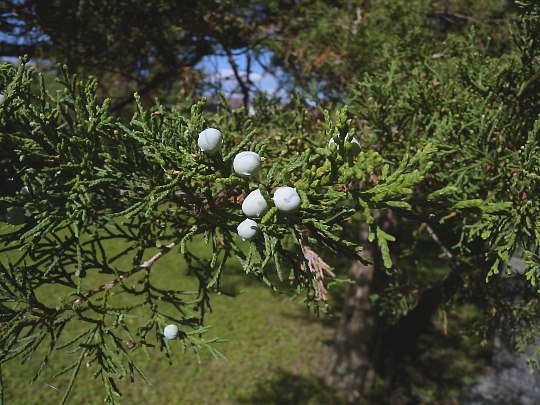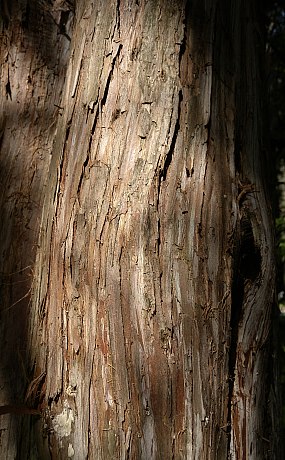Description: This evergreen coniferous tree is 30-80' tall, forming a short trunk and a crown that is ovoid, oblongoid, or conical in shape. The trunk is usually undivided at the base, although it may form 2 or more major branches above that are ascending. Smaller branches are more or less widely spreading, while young twigs are abundantly branched in various directions. Trunk bark is usually reddish brown, thin, and fibrous, tearing off in linear strips; on older slow-growing trees, it may become more gray and thick. Branch bark is brown or reddish brown and slightly flaky or bumpy, while young twigs are green and angular (they are largely hidden by the abundant leaves). Eastern Red Cedar produces two kinds of leaves: awl-shaped and scale-shaped. Awl-shaped leaves occur on trees only 1-3 years old and sometimes on older trees where there are vigorous shoots. Scale-shaped leaves are found on older trees (exceeding 3 years), where they are the dominant type of leaf. Awl-shaped leaves are 3-12 mm. (1/8–1/2") long and linear in shape, while scale-shaped leaves are 1.5-3 mm. (1/16–1/8") long and lanceolate-ovate in shape. Both types of leaves are hairless and they become dark green at maturity. The awl-shaped leaves are usually arranged oppositely in 2 or 4 ranks along the twigs, while the scale-shaped leaves are arranged oppositely in 4 appressed overlapping ranks.

Eastern Red Cedar is dioecious, producing pollen cones (male flowers) and seed cones (female flowers & fruits) on separate trees. The yellowish pollen cones are about 3 mm. (1/8") long and oblongoid to ovoid in shape; they are typically produced in large groups. They release their pollen to the wind during the spring and cross-pollinate the seed cones. The seed cones are initially green, but they later become pale blue from a waxy coating during the fall. Individual seed cones are about ¼" across, globoid, and berry-like in appearance; they are waxy-fleshy, sweet-tasting, and resinous. Each seed cone typically contains 1-2 bony seeds about 1/8" (3 mm.) long (rarely there are 3-4 seeds). The woody root system is shallow and spreading. This tree reproduces by reseeding itself.
Cultivation: The preference is full sun, mesic to dry conditions, and nutrient-poor soil containing gravel, sand, clay, or rocky material. Eastern Red Cedar is more tolerant of alkaline soil than most conifers. Under favorable conditions, it can be a relatively long-lived tree (up to 300 years, or more), but some trees die out at a comparatively young age from insects, disease, storm-damage, or competition from other species of trees. Because Eastern Red Cedar is an alternate host of a fungal disease, cedar-apple rust, it may not be desirable to plant this tree near apples and crab apples.
Range & Habitat: Eastern Red Cedar is a common native tree that is found throughout Illinois (see Distribution Map); it probably occurs in every county. Habitats include thin upland woodlands, rocky bluffs, wooded slopes, woodland edges, sandstone and limestone glades, rocky cliffs, stabilized sand dunes, sandy savannas, roadside embankments, gravelly areas along railroads, fence rows, old cemeteries, and abandoned fields. Sometimes Eastern Red Cedar is cultivated as a landscape plant and for windbreaks. This is a pioneer tree that colonizes sunny areas that are relatively dry and sterile. Because of its thin bark and low branches, it has poor resistance to fire.
savannas, roadside embankments, gravelly areas along railroads, fence rows, old cemeteries, and abandoned fields. Sometimes Eastern Red Cedar is cultivated as a landscape plant and for windbreaks. This is a pioneer tree that colonizes sunny areas that are relatively dry and sterile. Because of its thin bark and low branches, it has poor resistance to fire.
Faunal Associations: An interesting variety of insects feed on Eastern Red Cedar. These insects include the larvae of the Small Cedar Bark Borer (Atimia confusa confusa) and other wood-boring beetles, larvae of gall flies, plants bugs, the Juniper Aphid (Cinara juniperi) and other aphids, the Red Cedar Spittlebug (Clastoptera arborina), leafhoppers, the Red Cedar Scale (Aonidia shastae) and other scale insects, the Juniper Mealybug (Paracoccus juniperi), larvae of the Juniper Geometer (Patalene olyzonaria) and other moths, larvae of a butterfly, the Juniper Hairstreak (Callophrys gryneus), and several thrips. The Insect Table provides a more complete list of these insects. Because they are a source of carbohydrates and fats, the berry-like cones are eaten by many birds, including the Cedar Waxwing, Purple Finch, Pine Grosbeak, Eastern Bluebird, and American Robin. The Bird Table provides a more complete list of these birds. The Eastern Screech Owl and other birds often use Eastern Red Cedar for protective and/or nesting sites because of its dense evergreen branches (Belthoff & Ritchison, 1990). When this tree grows near bodies of water, its wood and bark are occasionally used by the American Beaver (Martin et al., 1951/1961). White-tailed Deer browse on the leaves, fruits, and twigs of this tree only to a minor extent (Sotala & Kirkpatrick, 1973; Myers et al., 2004).
Photographic Location: A cemetery in Urbana, Illinois.
Comments: Even though it is often referred to as a 'red cedar,' this tree is actually a juniper. Therefore, a more appropriate name for this species would be 'Eastern Red Juniper' or 'Eastern Juniper.' This is the only tree-like species of juniper that is native to Illinois. Two other native species, Juniperus communis (Ground Juniper) and Juniperus horizontalis (Trailing Juniper), are both low-growing shrubs that rarely exceed 3' in height (although some cultivars of Ground Juniper can be taller). In Illinois, they are typically found on sand dunes. Because of its tall erect habit, scale-shaped leaves, and pale blue seed cones, it is relatively easy to distinguish Eastern Red Cedar from other conifers.